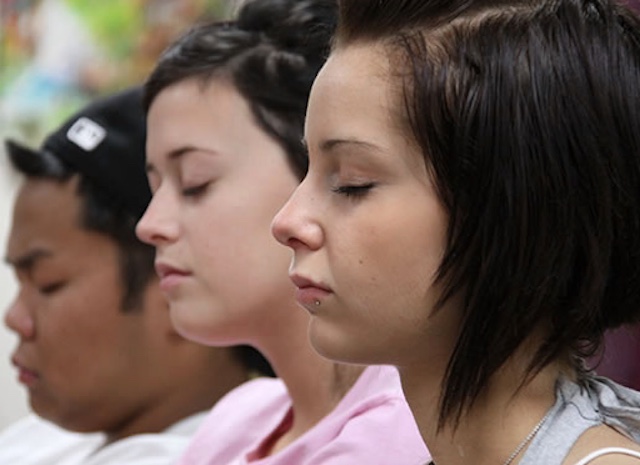As far as after-school detention goes, being forced to sit in a room against one’s will for an hour rarely promotes the personal reflection that leads to any behavior change—and that’s from the mouth of a high school principal, Jack Hatert.
His school, Yellow Springs High, along with nearby Mckinney Middle school, are giving students an alternative to classic detention by offering after-school mindfulness practice led by an expert. Every Monday for 30 minutes after classes end, students can sit down on a blanket in Donna Haller’s second-floor classroom and allow themselves a quiet moment to calm their emotions and focus on stillness, being present, and increasing awareness of themselves and their school environment.
Collectively, these emotional reset sessions sit at the heart of a new Ohio statewide education initiative encouraging schools and teachers to offer mindfulness training to students. Entitled “Each Child, Our Future,” Ohio’s new plan aims to offer resources to create well-rounded and capable young people, and perhaps also address the mental health epidemic in the United States.
RELATED: One in Three Americans Now Consider Meditation to Be Essential for the Perfect Morning, Says Poll
Social-emotional learning is one of the three fundamentals in this program, which hopes to create “processes through which children and adults acquire and effectively apply the knowledge, attitudes and skills necessary to understand and manage emotions, set and achieve positive goals, feel and show empathy for others, establish and maintain positive relationships and make responsible decisions”.
Along with mindfulness classes every Monday, Yellow Springs High offers yoga classes in the school library every Wednesday.
Donna Haller, has been at the high school for the past nine years and is a certified yoga and meditation instructor for both adults and youth of all ages.
CHECK OUT: How to Follow Negative News Without Getting Depressed
“I love it,” she told Yellow Springs News after one of her guided meditation classes during Wednesday’s yoga slot. “It does as much for me as them,” she said of the calming effects.
“Someone I know said that mindfulness and yoga have helped them with their ADHD and with processing an event where they had lost someone who was dear to them,” wrote freshman Isabella Beiring for a video project about the mindfulness and yoga program.
Sweeping the Nation
But Yellow Springs, Ohio is not the only town to feature meditation, mindfulness classes, or yoga as a potential game-changer for their students.
A 2017 survey from the National Institute of Health found that 1 in 12 children reported that they had practiced yoga during the previous 12 months—and between 2002 and 2012, the number of children and adults practicing yoga doubled in the country. Between 2012 and 2017, the number continued to increase, and Yellow Springs News reports that yoga classes are now being offered in more than 940 schools across the country.
The positive research about meditation and mindfulness training are fairly compelling—the benefits are easy to achieve, effective, and long-lasting. Studies have also demonstrated that yoga, particularly in students, can help improve responses to stress, process past events that may have been difficult, enhance social engagement, and possibly even improve academic performance.
MORE: More Schools Are Being Gifted Free Washing Machines From Whirlpool So Kids Don’t Skip School

The San Francisco Unified School District, as well as other schools across the country are implementing the Quiet Time program, started by Twin Peaks and Fight Club director David Lynch. Quiet Time consists of two fifteen minute sessions of transcendental meditation where students are encouraged to breathe deeply, clear their minds, and find their center.
According to the David Lynch Foundation for Consciousness-Based Education and World Peace website, the Quiet Time meditation program has shown a 65% decrease in violent conflict, a 40% reduction in stress and anxiety, and an 86% reduction in suspensions over a two year period along with a dramatic increase in self-confidence, creativity, and happiness.
Transcendental meditation is different in principle to mindfulness training and yoga, but the results for the layperson tend to be the same—calmness of heart and mind, reduced stress, anger, and anxiety, and better attendance records.
MORE: Meditation and Mindfulness Tips to Combat Everyday Worries and Life’s Big Questions
Be Sure And Share The Good News With Your Friends On Social Media




















To me that is going from bad to worse: Yoga is an Eastern anti-Christian religion.